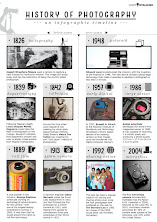The history of photography is a fascinating journey
that spans several centuries. Here's a brief overview of the key developments
and milestones in the evolution of photography:
Predecessors to Photography: The concept of
capturing images can be traced back to ancient times when the camera obscura, a
precursor to the camera, was used by artists to project images onto surfaces
for tracing. However, it wasn't until the 19th century that photography as we
know it today began to take shape.
Invention of the Camera: The first permanent
photographic image was produced in 1826 by Joseph Nicéphore Niépce, a French
inventor. He used a camera obscura and a light-sensitive material called bitumen
of Judea to capture the image. This early process, known as heliography,
required extremely long exposure times.
Daguerreotype: In 1839, Louis-Jacques-Mandé
Daguerre, a French inventor, announced the daguerreotype process, named after
him. It involved exposing a silver-coated copper plate to iodine vapor, then to
light to capture an image. The plate was developed with mercury vapor and fixed
with a solution of salt. Daguerreotypes provided highly detailed images but
were expensive and time-consuming.
Calotype and Paper-Based Processes: In the 1840s,
William Henry Fox Talbot, an English scientist, developed the calotype process.
It involved coating paper with silver iodide to make it light-sensitive and
producing a negative image that could be used to create multiple positive
prints. This process laid the foundation for modern photography by introducing
the concept of negatives.
Wet Plate Collodion: In 1851, Frederick Scott
Archer, an English photographer, introduced the wet plate collodion process. It
involved coating a glass plate with a collodion solution, sensitizing it in a
silver nitrate bath, exposing it while still wet, and developing the image
before the plate dried. This process provided sharper and faster results than
previous methods.
Dry Plate and Film: In the 1870s, Richard Leach
Maddox, an English physician, invented the dry plate process, which used a
gelatin emulsion on glass plates, eliminating the need for wet chemistry. This
made photography more convenient and portable. Eventually, flexible film made
of celluloid was introduced, leading to the development of roll film by George
Eastman and the founding of Kodak in the late 1880s.
Color Photography: The first color photograph was
taken in 1861 by James Clerk Maxwell using the three-color separation method.
However, it wasn't until the early 20th century that practical color processes
were introduced, such as Autochrome, a color transparency technique developed
by the Lumière brothers in 1907.
20th Century Innovations: The 20th century witnessed
numerous advancements in photography, including the introduction of smaller and
more portable cameras, such as the Leica in the 1920s, which popularized 35mm
film. The development of the 35mm SLR (Single-Lens Reflex) camera by Nikon and
Canon in the mid-20th century revolutionized professional photography.
Digital Photography: The advent of digital
technology in the late 20th century revolutionized photography. The first
digital camera was developed in 1975, but it wasn't until the 1990s that
digital cameras became widely available. Digital photography eliminated the
need for film and allowed for instant image preview, manipulation, and storage.
Since then, digital photography has continued to
evolve rapidly, leading to the rise of smartphone photography, advancements in
image sensors, and the development of high-resolution cameras capable of
capturing incredible detail.
The history of photography is a rich and complex.





0 Comments